
Next month's Vanity Fair features a fantastic dissection of Bear Stearns' collapse by Bryan Burroughs. One undercurrent the article explores is the role "trigger-happy reporters at CNBC" played in the Wall Street firm's demise. Burroughs' post-mortem suggests that managing CNBC reporters' egos was as high a priority to Bear Stearns executives as lining up billions of bailout dollars, and hints strongly that CNBC speculation helped topple the investment bank. Excerpts below:
Self-Fulfilling Prophecies: How Repeating Rumors Makes Them Fact
At Bear Stearns, no one was laughing. Publicly speculating on a firm's liquidity is akin to shouting "Fire!!!" in a crowded theater; in catastrophic cases it can trigger panic selling. It risks, in other words, becoming a self-fulfilling prophecy.
For the next hour the Bear Stearns rumor became a topic of conversation between CNBC correspondents and various market traders and analysts. At 1:50, Matthew Cheslock remarked, "The sentiment [on Bear] is pretty negative. The general consensus is 'Where there's smoke, there's fire.' "
A few minutes later, Griffeth, perhaps sensing the network might have gone a bit too far, asked Dennis Kneale, "What about the jittery nature of this market right now? Are we starting to believe some rumors that may or may not be true?" Kneale agreed. "Someone," he observed, "is always making money on the other side of that bad news or that rumor."
Yet CNBC's coverage remained anything but skeptical of the rumor. At two the network's new "money honey," Erin Burnett, headlined the hour by announcing "credit issues at Bear," never mind that there was no such thing. She turned to correspondent David Faber, who observed, "Of course, no firm's ever going to say that they are having trouble with liquidity, and, in fact, you've either got liquidity or you don't. So if you don't have it, you're done. Those are the kinds of concerns in this market, concerns of confidence You can have crises of confidence, causing meltdowns."
Managing CNBC Egos
Sam Molinaro felt it was time for another public assurance. CNBC's Charlie Gasparino had been peppering him with phone calls seeking comment. Molinaro talked to Russell Sherman, who felt Gasparino could be played. "He'll say something negative if you shut him out. But if you talk to him, he'll go positive," one Bear executive told me.
Around three, Molinaro spoke to Gasparino, telling him, "I've spent all day trying to track down the source of the rumors, but they are false. There is no liquidity crisis. No margin calls. It's all nonsense." Gasparino's on-air comments were mild, but for the first time he raised the specter of a nightmare scenario: "They are really worried about this inside [Bear], that these rumors are taking a very nasty turn, and they might cause a run on the bank." Still, by day's end, there was no rush among Bear's lenders to withdraw cash from the firm. At that point, this executive says, "the notion of a liquidity crisis seemed silly."
That night Schwartz, Molinaro, and others discussed what to do. The talks centered on whether Schwartz should go public in an interview with CNBC. "We debated putting Alan on the air a long time," says one board member. "Yes, it might draw attention to the rumors. But it would definitely answer the questions. Our view was: we had to get him out."
Schwartz, though, wanted some assurances first. From experience, he knew he faced a risk in picking the wrong CNBC correspondent for the interview. All the network's talent--Gasparino, Maria Bartiromo, Faber, Larry Kudlow--had requested the interview, and whoever didn't get it, Schwartz feared, might retaliate on the air. "Each of these correspondents has his own producer, and they all seem to hate each other," one Bear executive told me. "If you choose Faber, you know Bartiromo will bash you the next day." Schwartz directed Russell Sherman to identify the CNBC executive who supervised the correspondents, explain the situation, and ask that the correspondents who didn't get the interview refrain from attacks. Sherman, however, couldn't identify a single CNBC executive who seemed to have control over the correspondents. "Everyone on Wall Street knows the joke," says another Bear executive involved in the discussions. "At CNBC, there is simply no adult supervision."
The Deadly Interview
Faber's first question was a bombshell. He told Schwartz he had direct knowledge of a trader--a single trader--whose credit department had held up a trade with Bear Stearns, citing concerns about its health. At Bear, many executives gasped. It was a killer statement: Faber was saying, in essence, that Bear's status as a trader, the basis of its business, was in question. Schwartz answered as best he could, saying everything was fine; only later did Faber say on-air the trade in question had finally gone through. But the damage had been done.
"You knew right at that moment that Bear Stearns was dead, right at the moment he asked that question," a Wall Street trader of 40 years told me. "Once you raise that idea, that the firm can't follow through on a trade, it's over. Faber killed him. He just killed him."
Read the entire Vanity Fair article here.
To watch the fateful interview, visit the New York Times.
